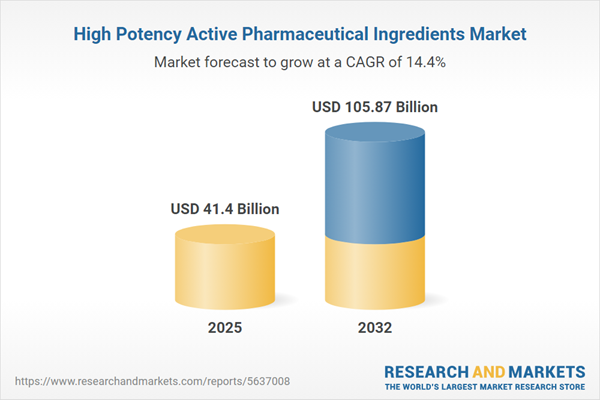Speak directly to the analyst to clarify any post sales queries you may have.
Senior decision-makers navigating the high potency active pharmaceutical ingredients (HPAPI) market must contend with evolving therapeutic requirements, increased regulatory scrutiny, and ongoing pressures to streamline operations while ensuring innovation. Understanding current market forces is crucial for aligning business strategy, fostering innovation, and managing risk across the HPAPI landscape.
Market Snapshot: HPAPI Market Size and Growth
The HPAPI market is experiencing dynamic growth, with valuations rising from USD 36.14 billion in 2024 to USD 41.40 billion in 2025, and projected to reach USD 105.87 billion by 2032. A resilient compound annual growth rate (CAGR) of 14.37% underscores strong demand across therapy areas such as cardiology, oncology, neurology, and infectious diseases. This performance illustrates the industry’s adaptability and the impact of investments in advanced manufacturing and regulatory compliance. Market participants enhance their competitiveness by responding swiftly to therapeutic advances and implementing innovative, patient-centered solutions within a fast-changing regulatory environment.
Scope & Segmentation of the High Potency Active Pharmaceutical Ingredients Market
- Type: Biologics advance personalized medicine for complex conditions, while small molecule HPAPIs offer flexible application and simple scaling in diverse therapeutic areas.
- Therapeutic Area: Cardiology, oncology, neurology, and infectious diseases are primary application fields, emphasizing the significance of tailored therapies and improved clinical outcomes.
- Source: Natural, synthetic, and semi-synthetic HPAPIs present distinct process and compliance challenges, affecting how companies design regulatory paths and accelerate commercialization.
- Dosage Form: Both oral and injectable formats broaden patient access, supporting a seamless fit into inpatient and outpatient care settings and enabling diverse clinical application.
- Manufacturing Process: Batch and continuous manufacturing processes help balance cost control and quality standards, while automation provides a structured approach to regulatory alignment.
- End User: Pharmaceutical manufacturers, contract manufacturing organizations (CMOs), and research institutions contribute expertise, rapid development cycles, and advanced capabilities to maintain market positioning.
- Regional Coverage: The Americas and Europe lead in regulatory rigor and product quality, whereas Asia-Pacific demonstrates rapid commercialization and attracts investment due to efficient scale-up and research capacity.
- Featured Companies: Lonza Group Ltd, WuXi AppTec Co., Ltd, Catalent, Thermo Fisher Scientific, Siegfried Holding, Cambrex, Piramal Pharma, Jubilant Life Sciences, Alcami Corporation, and Recipharm AB are recognized for advancing technology, compliance, and operational efficiencies in the HPAPI sector.
Key Strategic Takeaways for Senior Leadership
- Advanced investments in containment and automation reduce operational risk, enhance process consistency, and ensure adherence to stringent HPAPI safety and quality standards.
- Effective management of evolving regulatory and environmental expectations helps organizations strengthen risk control and future-proof business frameworks.
- Emphasis on agile HPAPI reformulation equips companies to respond to the growing demands of personalized medicine and shifting patient requirements.
- Asia-Pacific’s role as an expanding production hub is reinforced by regional strengths in manufacturing pace and capacity, while established areas concentrate on compliance and operational discipline.
- Partnerships with contract manufacturing organizations provide access to specialized skills, enabling enterprises to adapt to shifting project requirements and streamline routes to market.
- The adoption of digital technologies and advanced analytics empowers leadership with sharper insights, condensed product development cycles, and greater responsiveness to changing market conditions.
Tariff Impact on HPAPI Supply Chains
Recent modifications to United States tariff policies are driving increases in HPAPI supply chain costs. Businesses are countering these pressures by diversifying their supplier portfolios, exploring near-shoring models, and reinforcing operational compliance at every level. Strategic measures such as enhanced inventory oversight and flexible demand planning help organizations adapt, ensuring resilience in an unpredictable global trade landscape.
Methodology & Data Sources
The insights presented in this report are based on direct interviews with HPAPI industry experts, comprehensive reviews of regulatory and technical documentation, and established frameworks including SWOT and PESTEL analyses. Together, these methods offer a solid foundation for practical compliance and informed risk management in executive planning.
Why This HPAPI Market Report Matters for Senior Decision-Makers
- Delivers a holistic perspective on HPAPI market dynamics, providing actionable supply chain strategies within shifting regulatory parameters.
- Equips leadership with practical solutions to maintain operational adaptability and compliance as therapy priorities evolve.
- Supports decision-making with key insights that help drive organizational resilience, strategic alignment, and sustained value in the regulatory-intensive HPAPI industry.
Conclusion
Timely access to focused HPAPI market analysis enables senior executives to steer innovation, optimize compliance, and sustain a strategic edge as industry conditions evolve.
Additional Product Information:
- Purchase of this report includes 1 year online access with quarterly updates.
- This report can be updated on request. Please contact our Customer Experience team using the Ask a Question widget on our website.
Table of Contents
3. Executive Summary
4. Market Overview
7. Cumulative Impact of Artificial Intelligence 2025
Companies Mentioned
The companies profiled in this High Potency Active Pharmaceutical Ingredients market report include:- Lonza Group Ltd
- WuXi AppTec Co., Ltd
- Catalent, Inc.
- Thermo Fisher Scientific Inc.
- Siegfried Holding AG
- Cambrex Corporation
- Piramal Pharma Limited
- Jubilant Life Sciences Limited
- Alcami Corporation
- Recipharm AB
Table Information
| Report Attribute | Details |
|---|---|
| No. of Pages | 180 |
| Published | October 2025 |
| Forecast Period | 2025 - 2032 |
| Estimated Market Value ( USD | $ 41.4 Billion |
| Forecasted Market Value ( USD | $ 105.87 Billion |
| Compound Annual Growth Rate | 14.3% |
| Regions Covered | Global |
| No. of Companies Mentioned | 11 |









